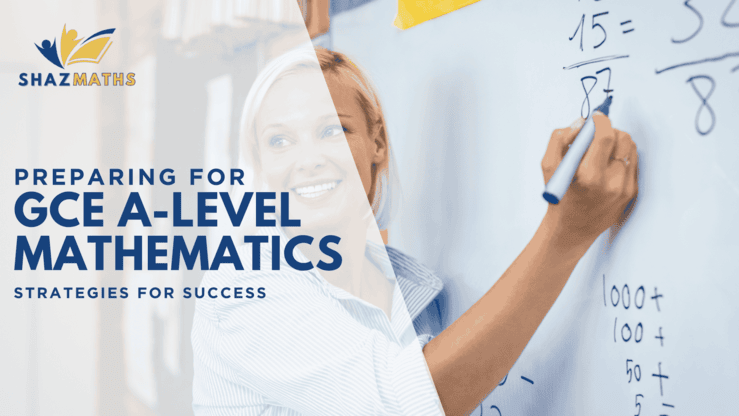If your teen is studying GCE A-Level Mathematics, you already know it’s not a walk in the park. Between the abstract concepts in Pure Math, the real-world applications in Mechanics, and the data-driven challenges of Statistics, this subject demands both focus and flexibility. But don’t worry—success isn’t about being a genius. It’s about having the right preparation strategy and knowing how to work smart.
Whether your child is just starting or getting closer to exam time, this guide offers practical tips for GCE A-Level Mathematics preparation—without the stress or overwhelm.
Why GCE A-Level Mathematics Can Feel Challenging
A-Level math is a step up from IGCSE. It goes deeper into theory, logic, and application, requiring students not just to solve problems but to understand them.
Some of the challenges students face include:
- Jumping from basic algebra to calculus and vectors
- Applying concepts to real-life contexts in mechanics
- Understanding probability and statistical distributions
The key is building confidence through steady, consistent A-Level math revision and learning how to break complex topics into manageable steps.
Getting Started: Know the GCE A-Level Mathematics Syllabus
The first step in preparing is understanding what your child is expected to know. Each exam board—like Cambridge International or Edexcel—structures their syllabus differently, but all include three main areas:
- Pure Mathematics – algebra, calculus, trigonometry, logarithms
- Statistics – data interpretation, probability, distributions
- Mechanics – motion, forces, and Newton’s laws
Before you dive into solving problems, take time to review the syllabus or paper codes. This clarity helps make sure no topic is left behind.
Read More: How to Find the Right Online Tutor in Australia
Organise a Balanced Study Plan
How to study A-Level math efficiently? It starts with a good plan.
A common mistake students make is doing random topics here and there. But a structured plan can make revision feel less chaotic and more productive.
Here’s a simple weekly approach:
- 2 days on Pure Math – Focus on concepts and practice questions.
- 1 day on Statistics – Use real-world examples for better understanding.
- 1 day on Mechanics – Work through diagrams and step-by-step solutions.
- 1 day for past papers – Simulate real exam conditions.
- 1 day review – Revisit weak areas and update your study notes.
And yes, one day off is important too. Brains need rest to retain what they’ve learned.
Practice Makes Progress
When it comes to GCE A-Level Mathematics, there’s no replacement for practice. But not all practice is equal.
Here’s how to get the most from your revision:
- Use exam-style questions from the beginning—not just textbook problems.
- Mark your answers using the actual mark schemes to understand how points are awarded.
- Keep a “mistake notebook” where you jot down common errors and what you learned from them.
- Set a timer. Learning to manage time under pressure is a key exam skill.
The more your child exposes themselves to the types of questions they’ll face, the more comfortable and confident they’ll feel.
Master Exam Strategy, Not Just Content
Sometimes students know the math—but still lose marks. That’s where good GCE math exam tips come in.
Here are some habits to develop:
- Read each question carefully. Underline key terms.
- Write every step clearly—even if the final answer is obvious.
- Don’t get stuck on one tough problem. Move on and come back.
- Label diagrams and graphs clearly.
Practising with these habits before exam day can really make a difference.
Don’t Ignore Statistics and Mechanics
Many students feel naturally drawn to Pure Math and unintentionally neglect Statistics and Mechanics. But these parts count just as much in your final grade.
In Statistics, focus on interpreting data and applying formulas like the normal distribution. Think about why certain methods are used in context.
In Mechanics, it’s all about understanding physical problems. Diagrams are your best friend here—use them to visualise what’s going on before diving into the math.
Balancing all three parts of the syllabus helps avoid nasty surprises in the exam.
Use the Right Resources
Thanks to the internet, there’s no shortage of resources—but quality matters.
Look for materials that are:
- Aligned with your exam board (Cambridge or Edexcel)
- Written in clear, student-friendly language
- Focused on practice and explanation—not just theory
Popular platforms like Physics & Maths Tutor or ExamSolutions are helpful. And if your child needs extra guidance, GCE math tutoring can provide personalised support and feedback.
Stay Positive and Consistent
Sometimes it’s not the math itself but the pressure that gets to students. Preparing for A-Levels can feel like a lot—but breaking things down day by day really helps.
- Encourage your child to take regular breaks.
- Make time for hobbies and rest.
- Celebrate small wins—mastering a topic, getting a past paper right, asking a great question in class.
Consistency beats cramming every time.
Shazmaths Can Support Your Child’s Math Journey
If you’re looking for that extra layer of support, Shazmaths offers personalised tutoring for GCE A-Level Mathematics—both face-to-face in Melbourne and through flexible online sessions.
Here’s how we help:
- One-on-one support tailored to your child’s needs
- Tutors experienced in both Cambridge and Edexcel syllabi
- Clear explanations that build confidence, not confusion
- Weekly progress updates and guided revision plans
We understand how important A-Level results are for university pathways and beyond. At Shazmaths, our goal is simple: to make math make sense—for every student.


